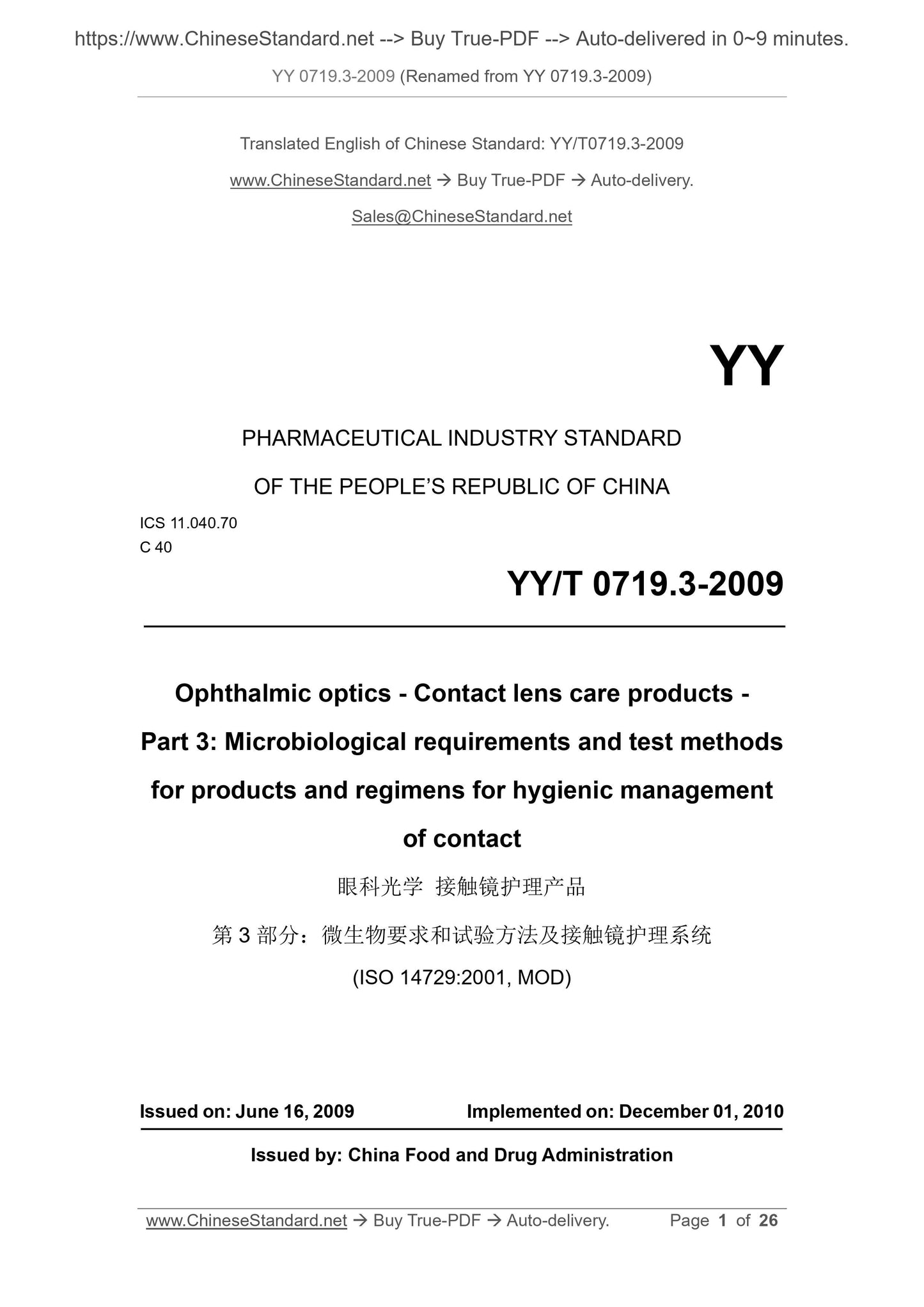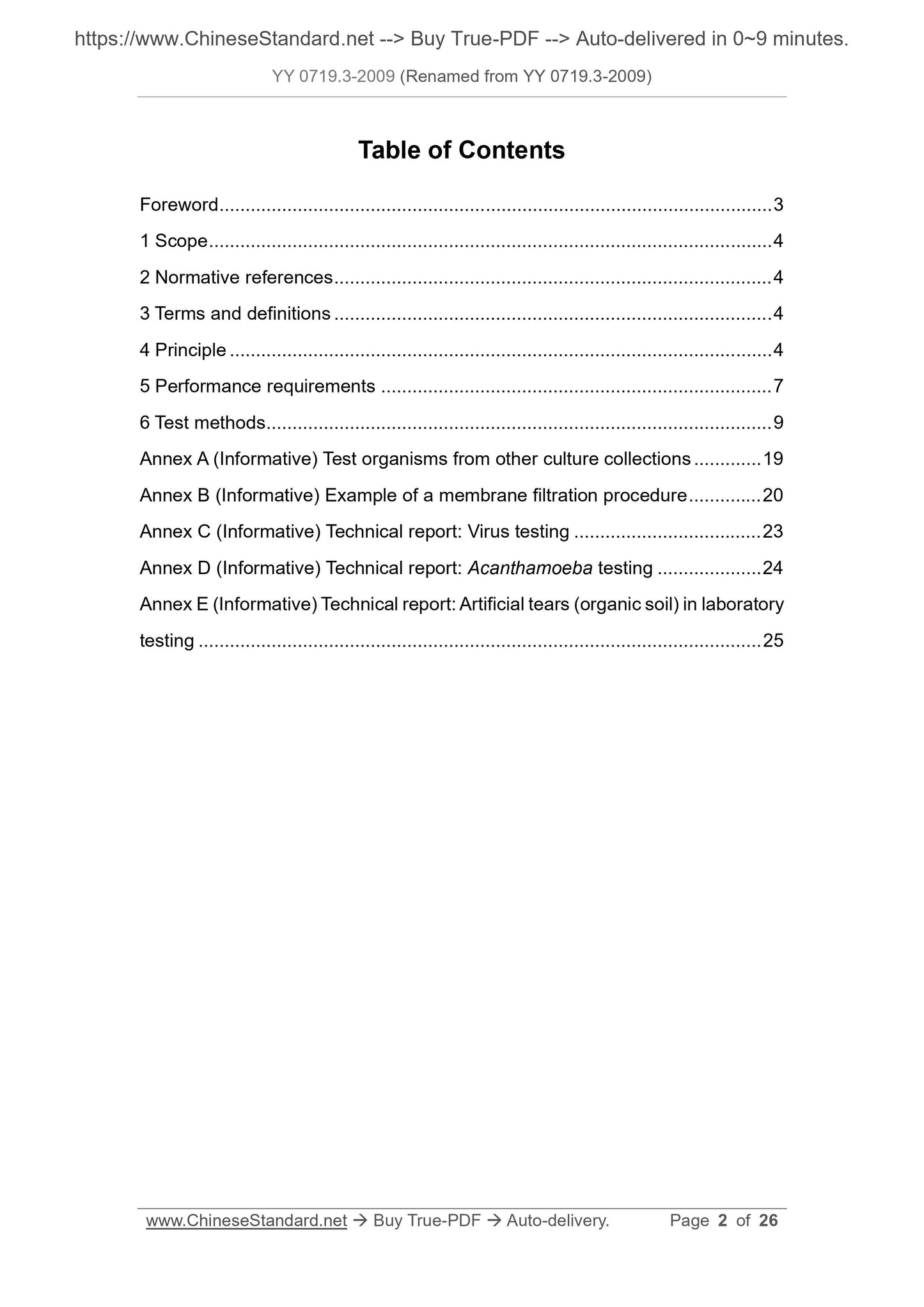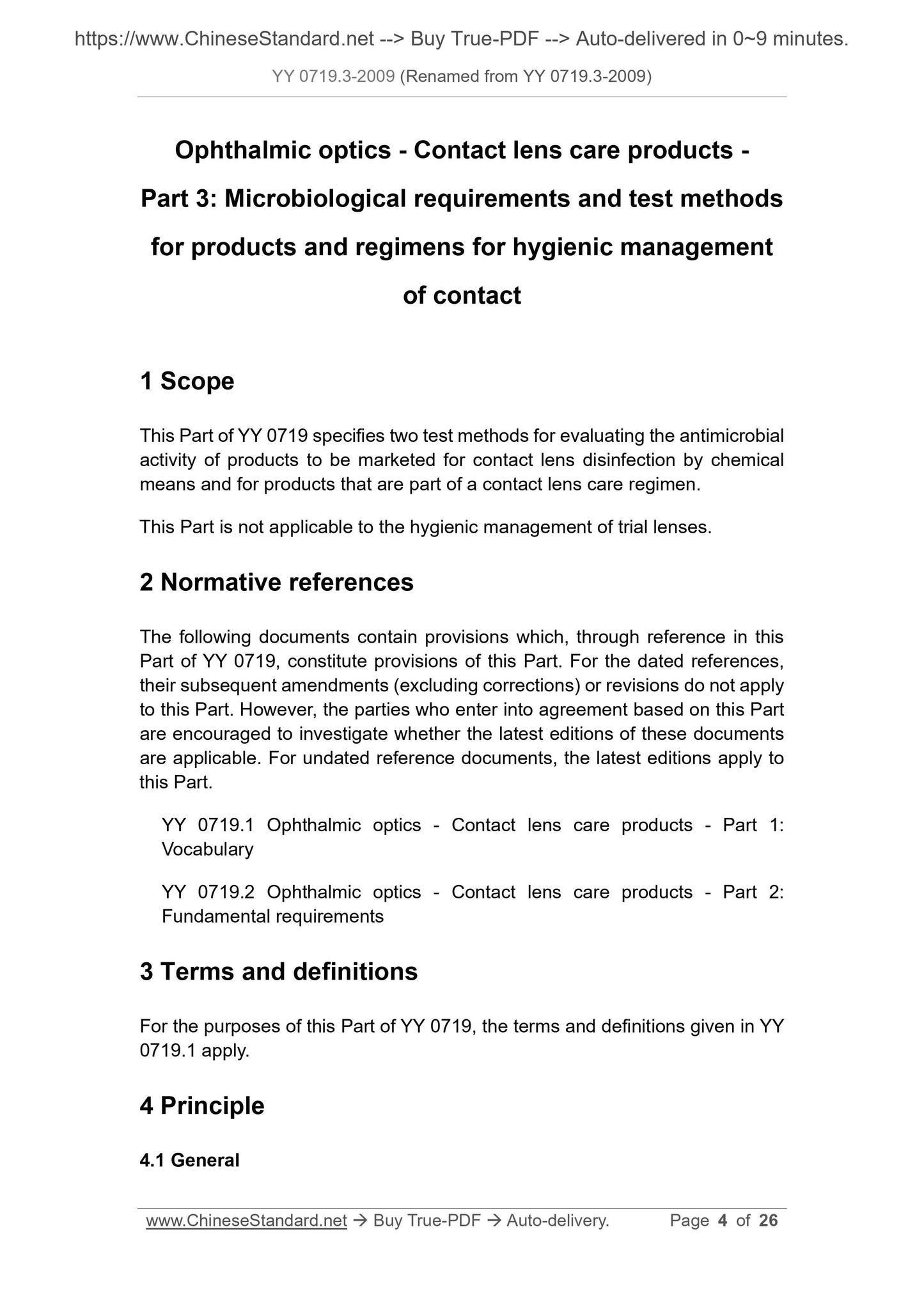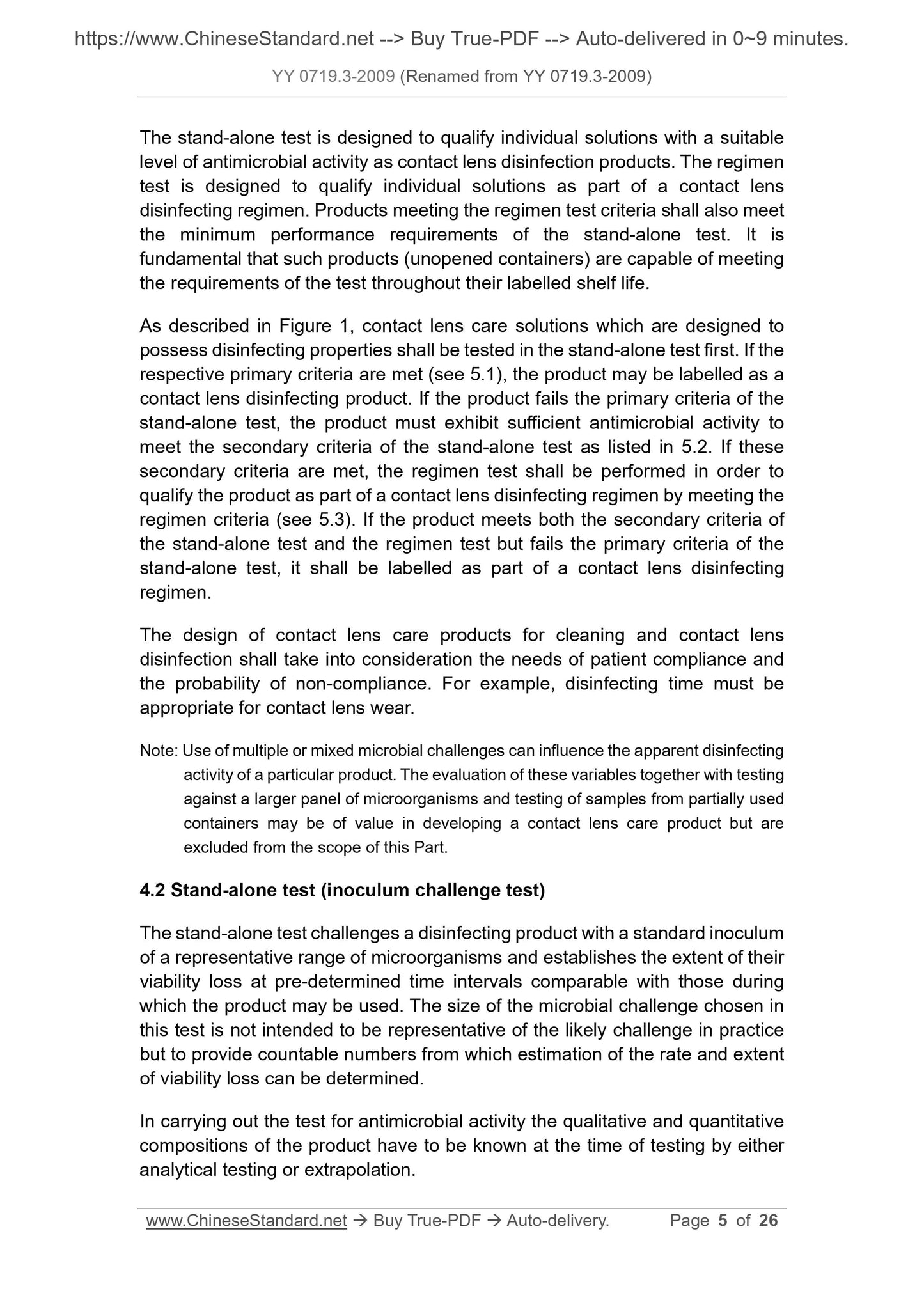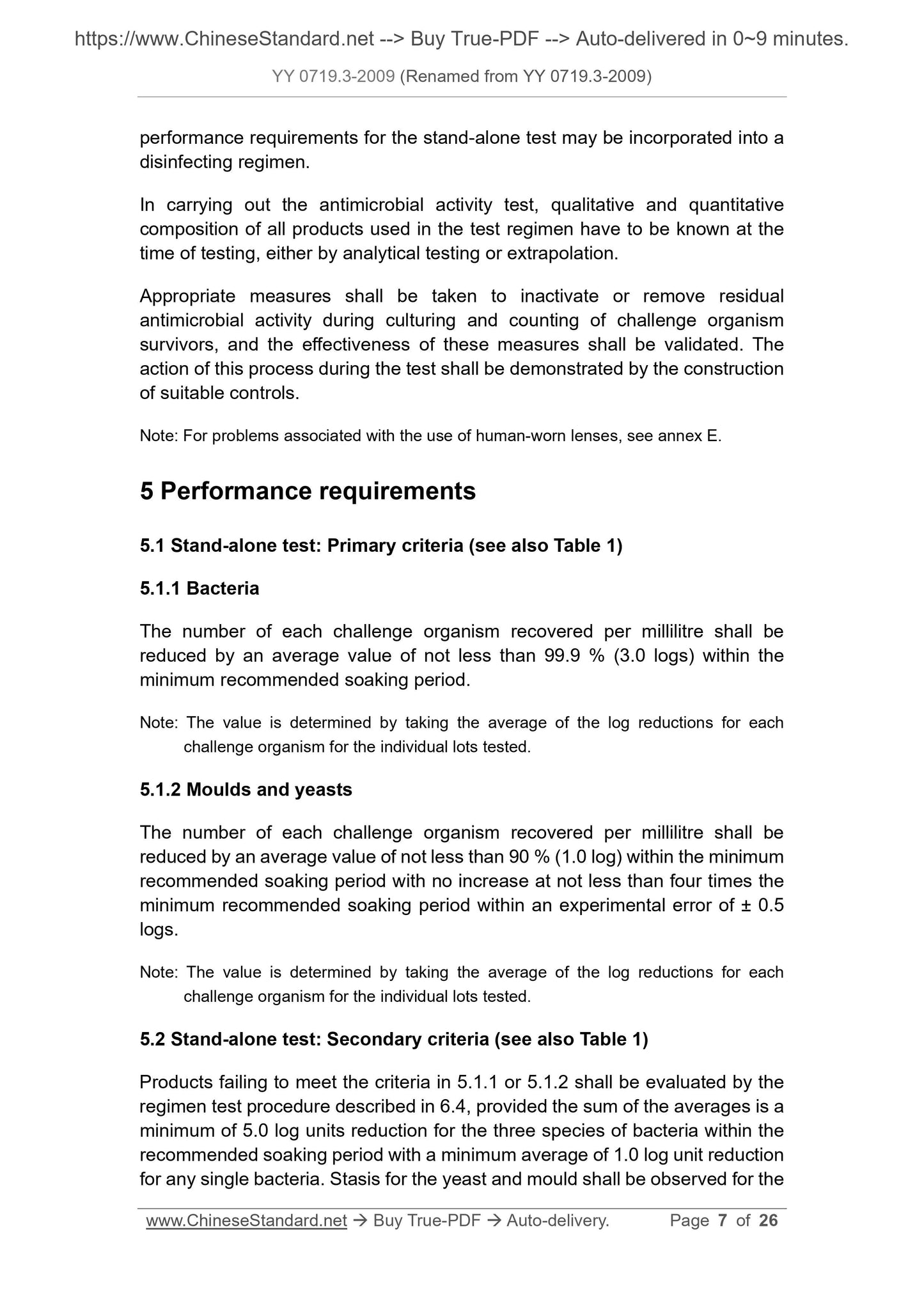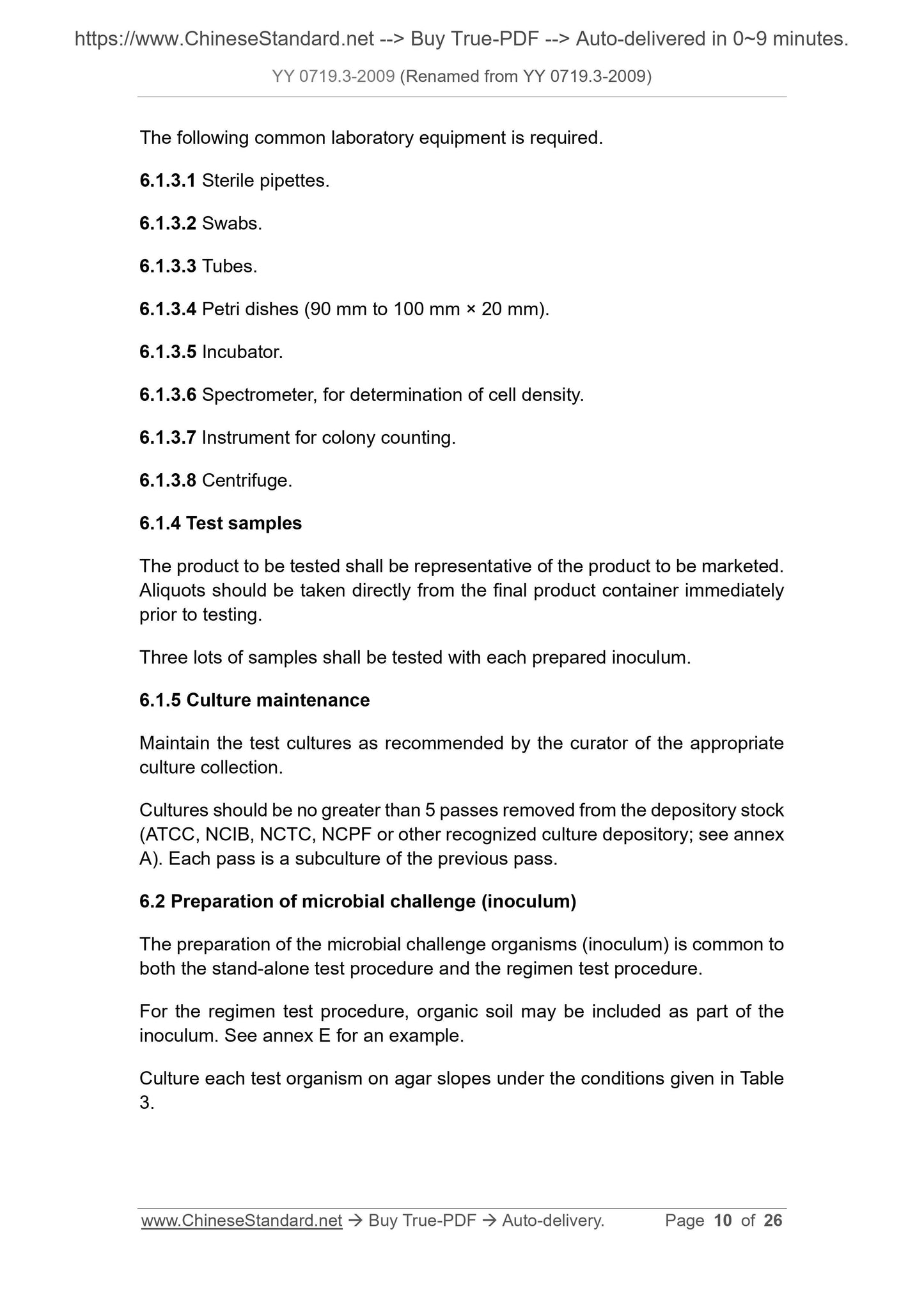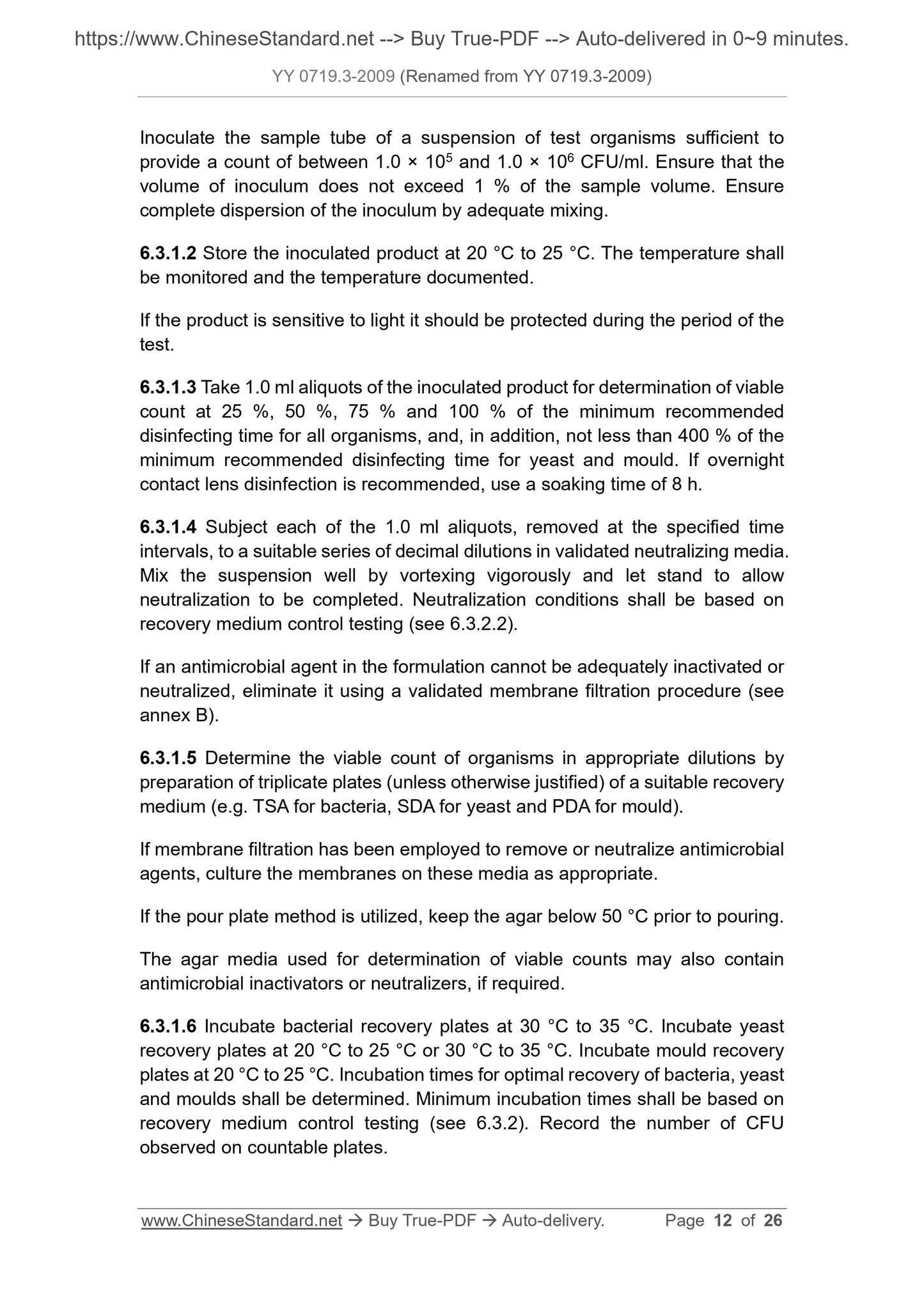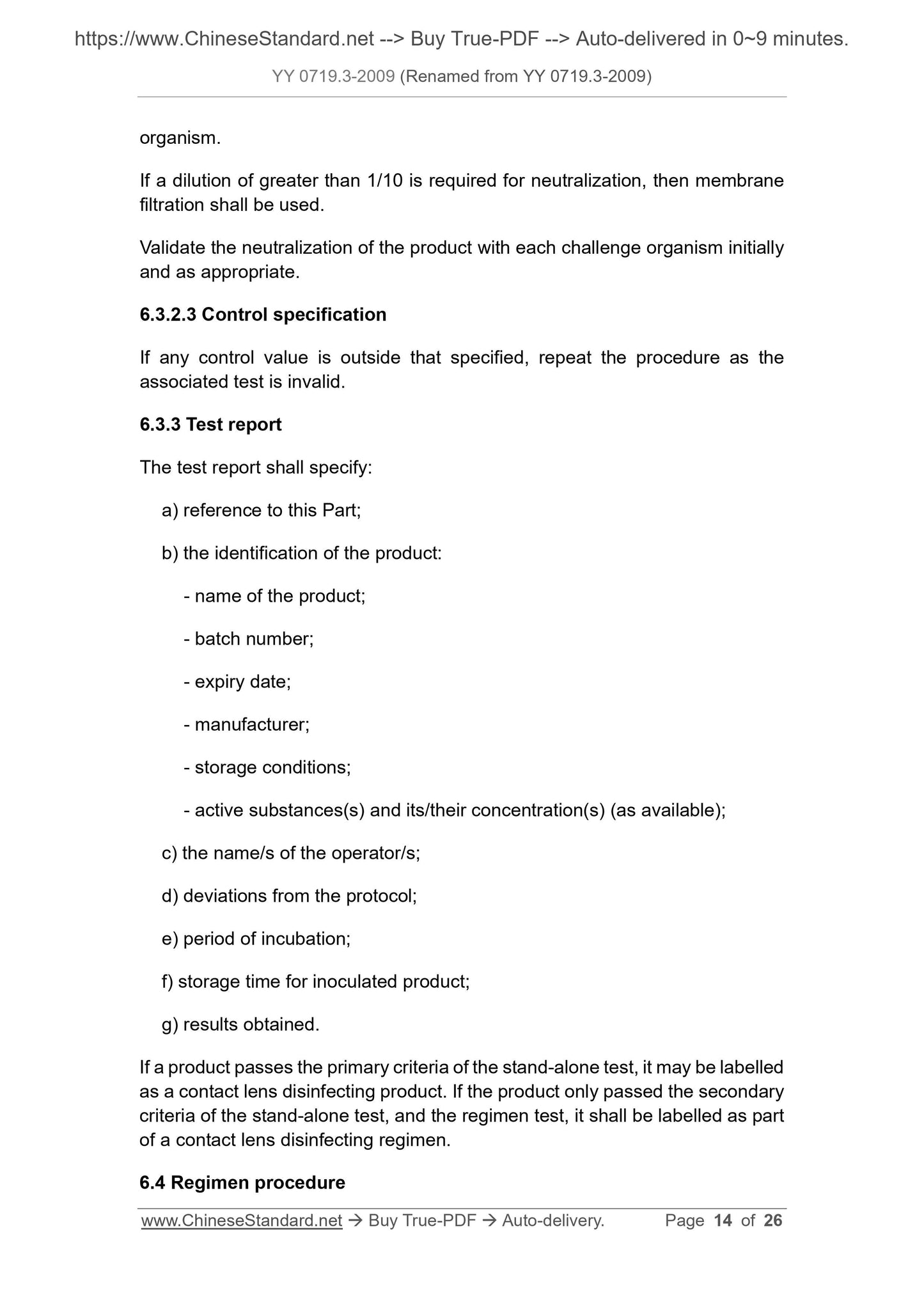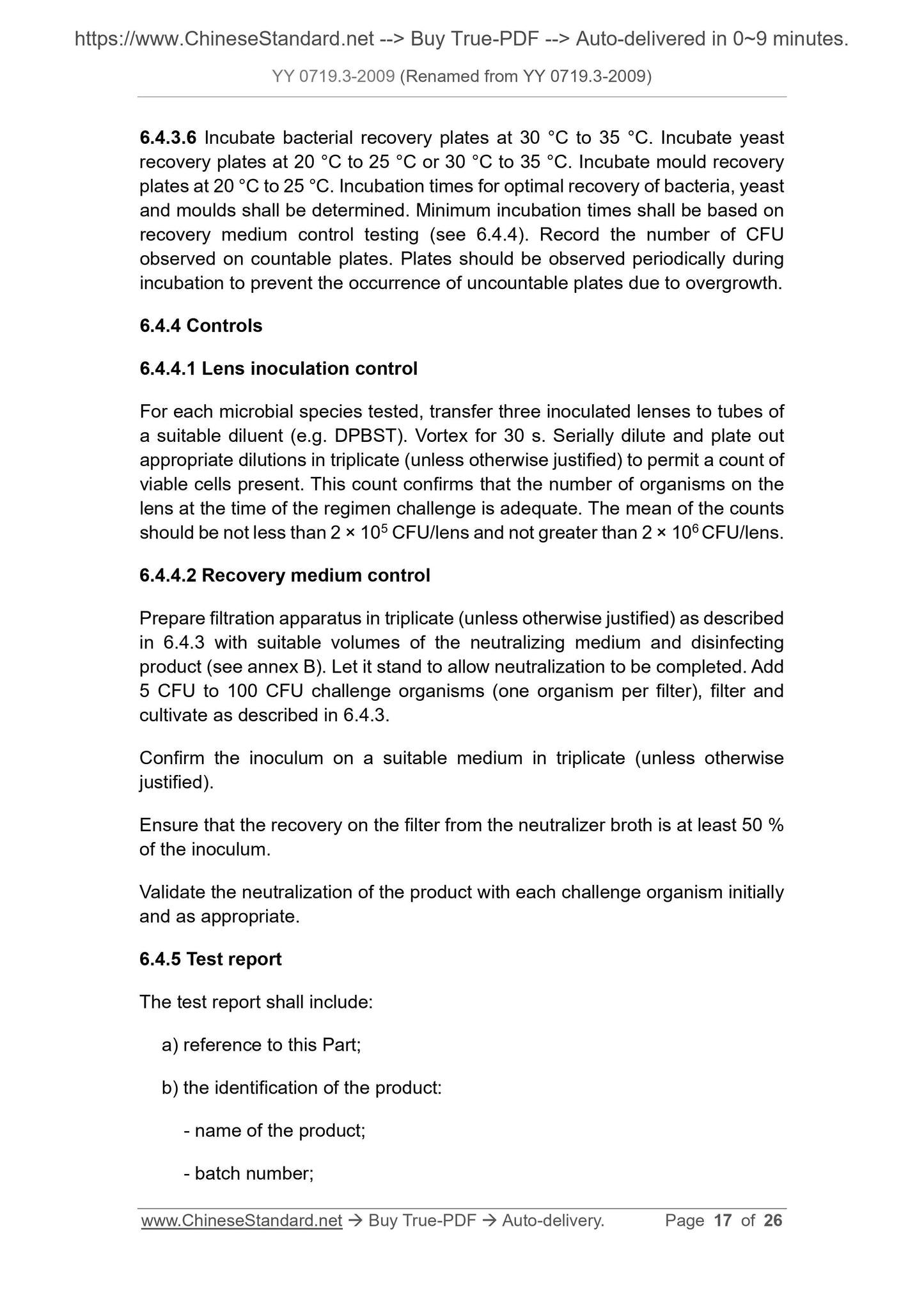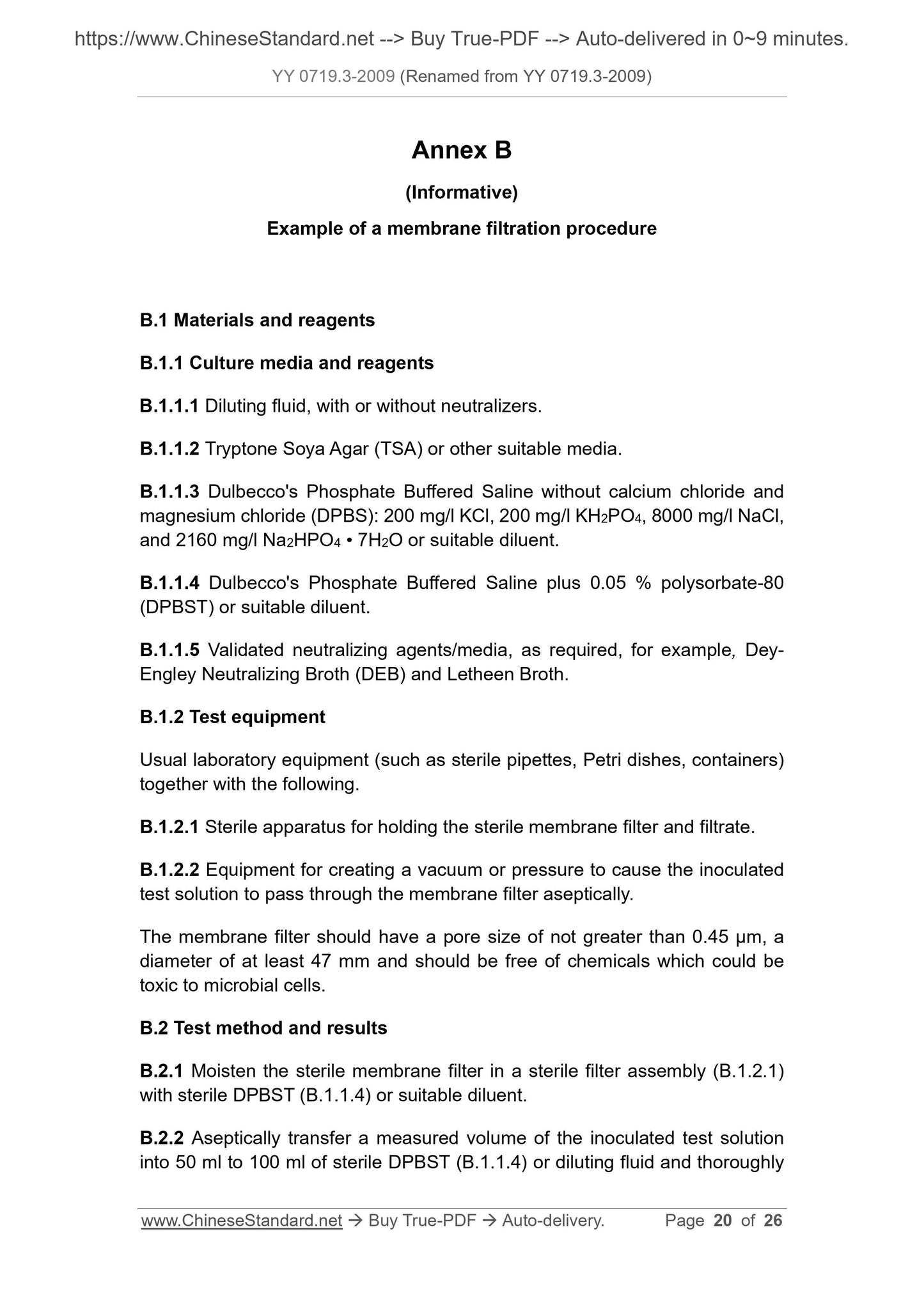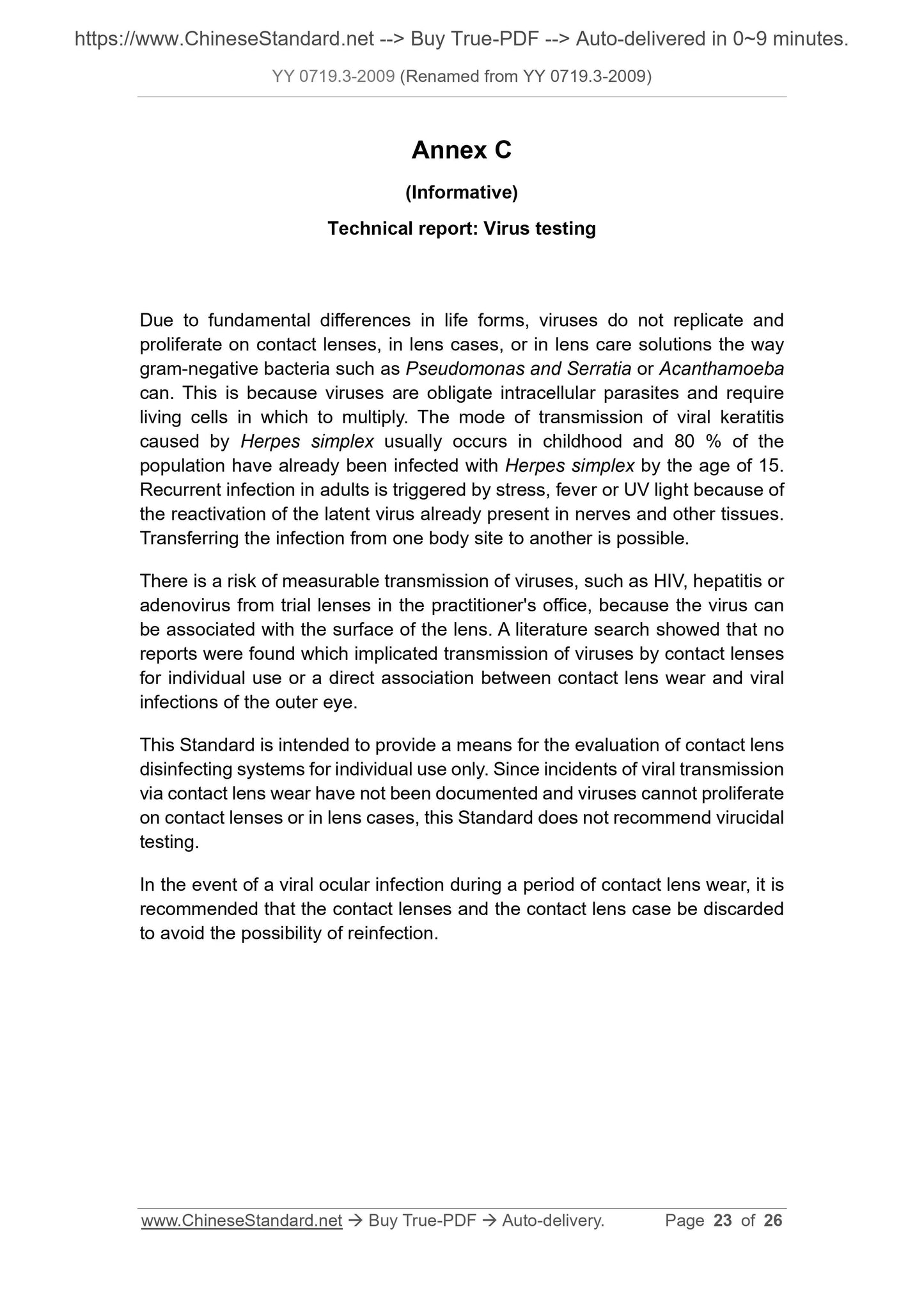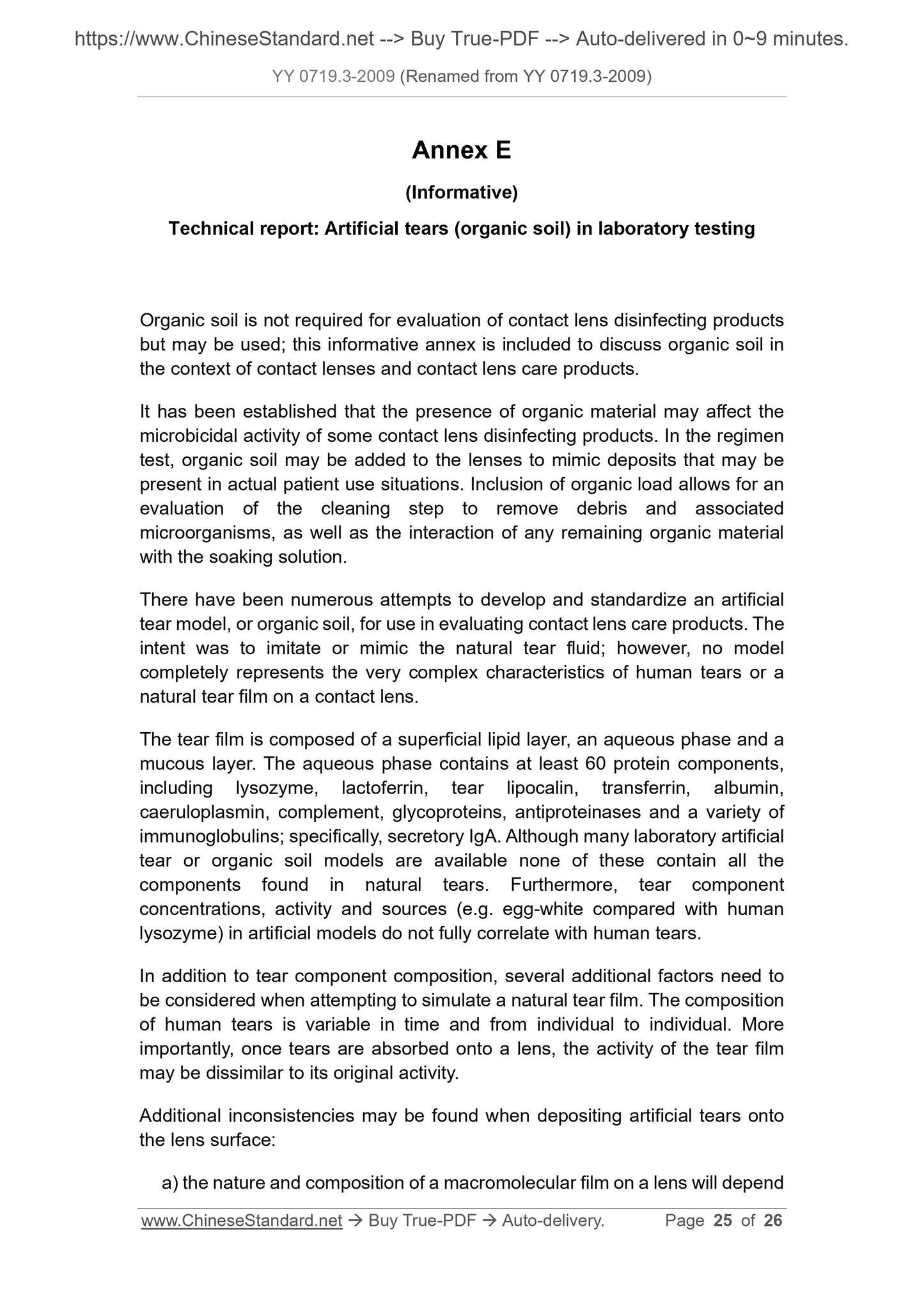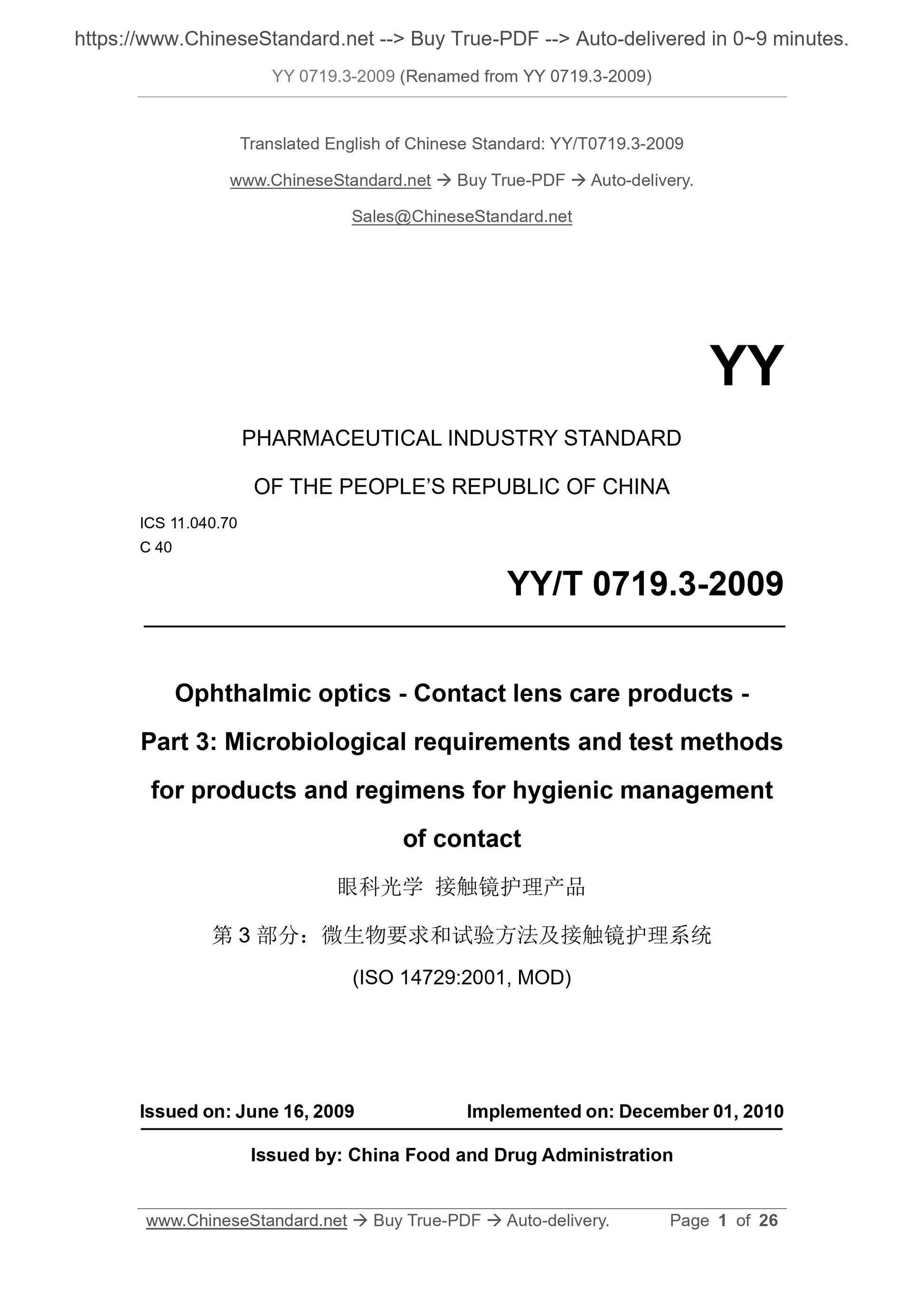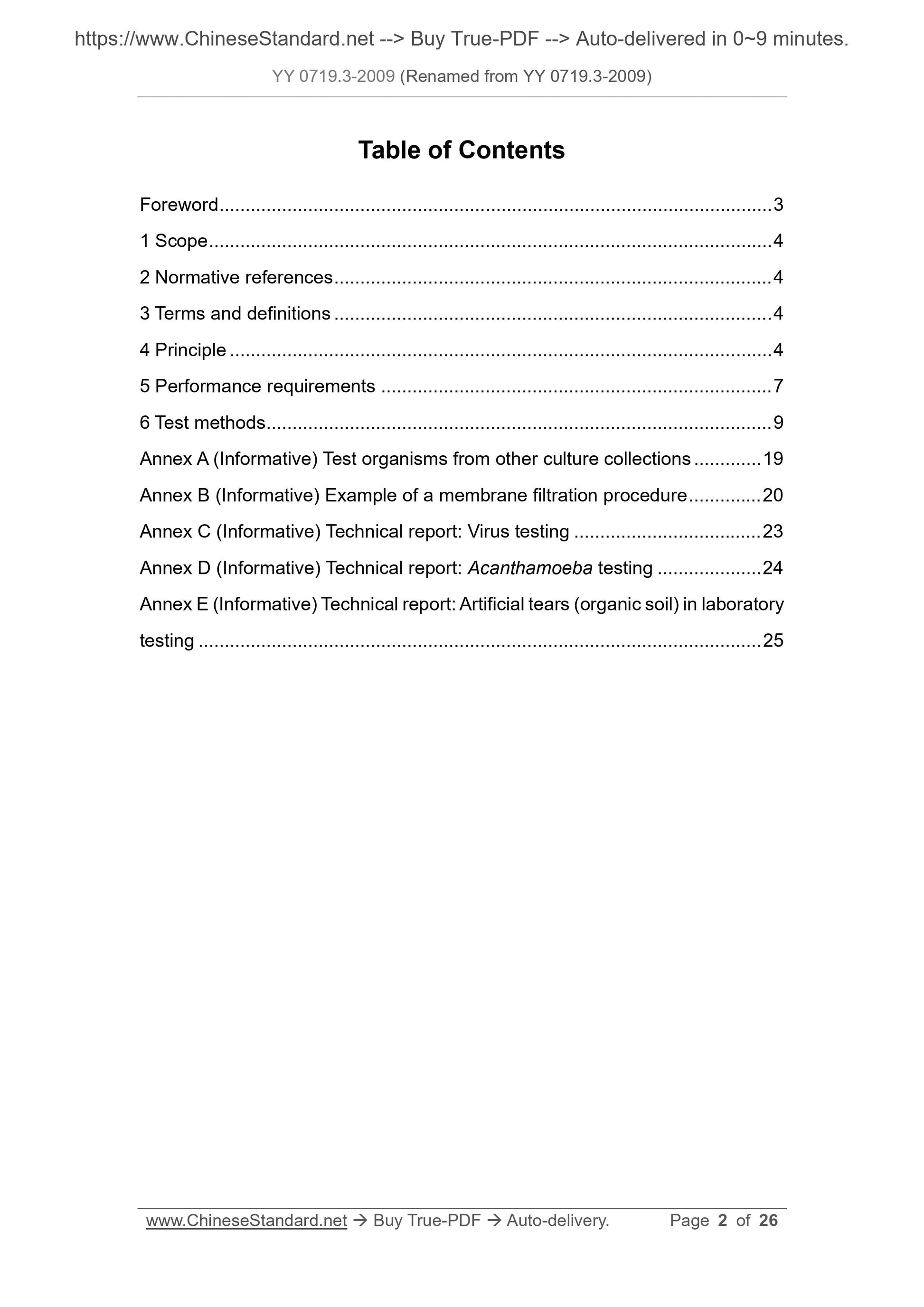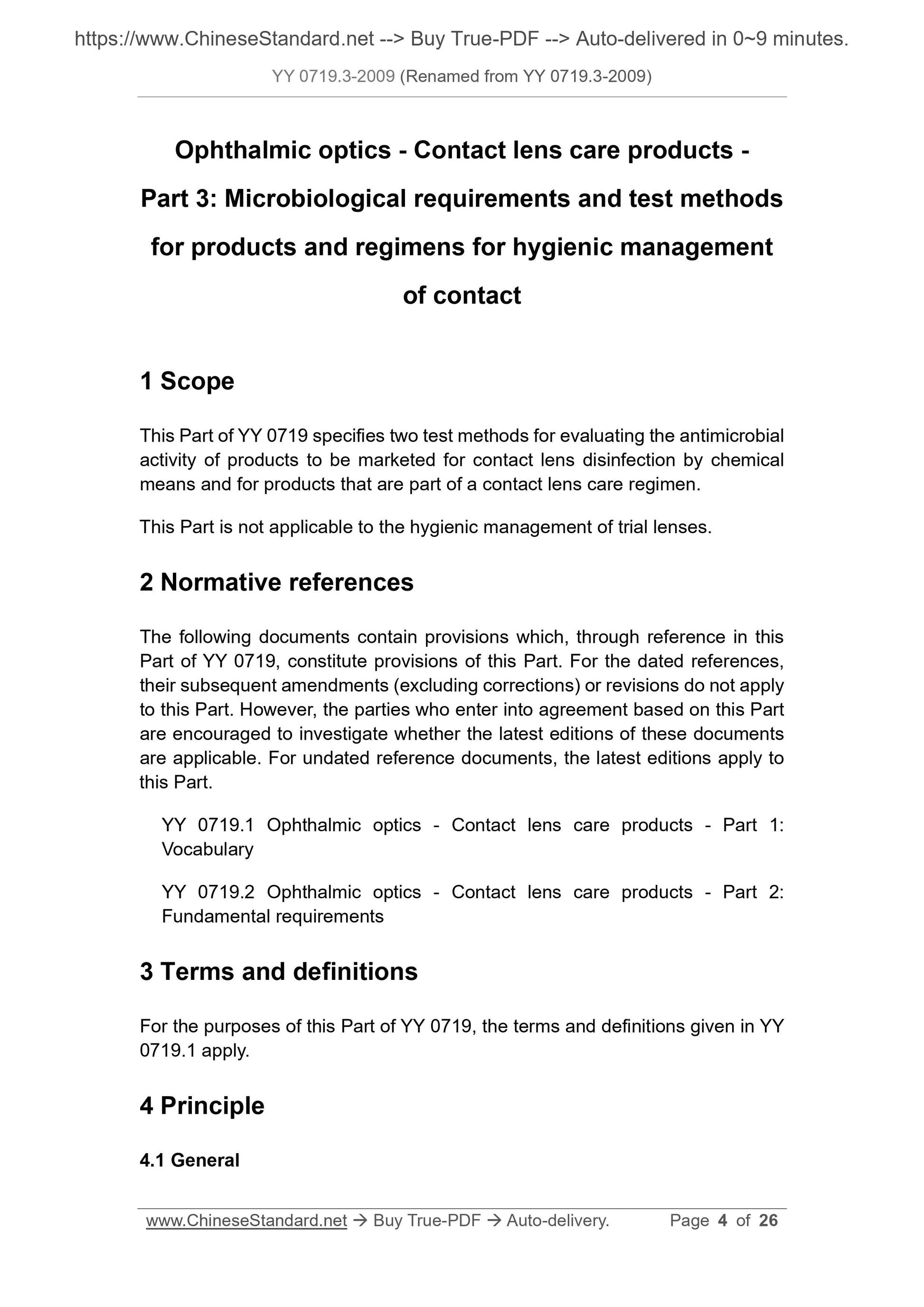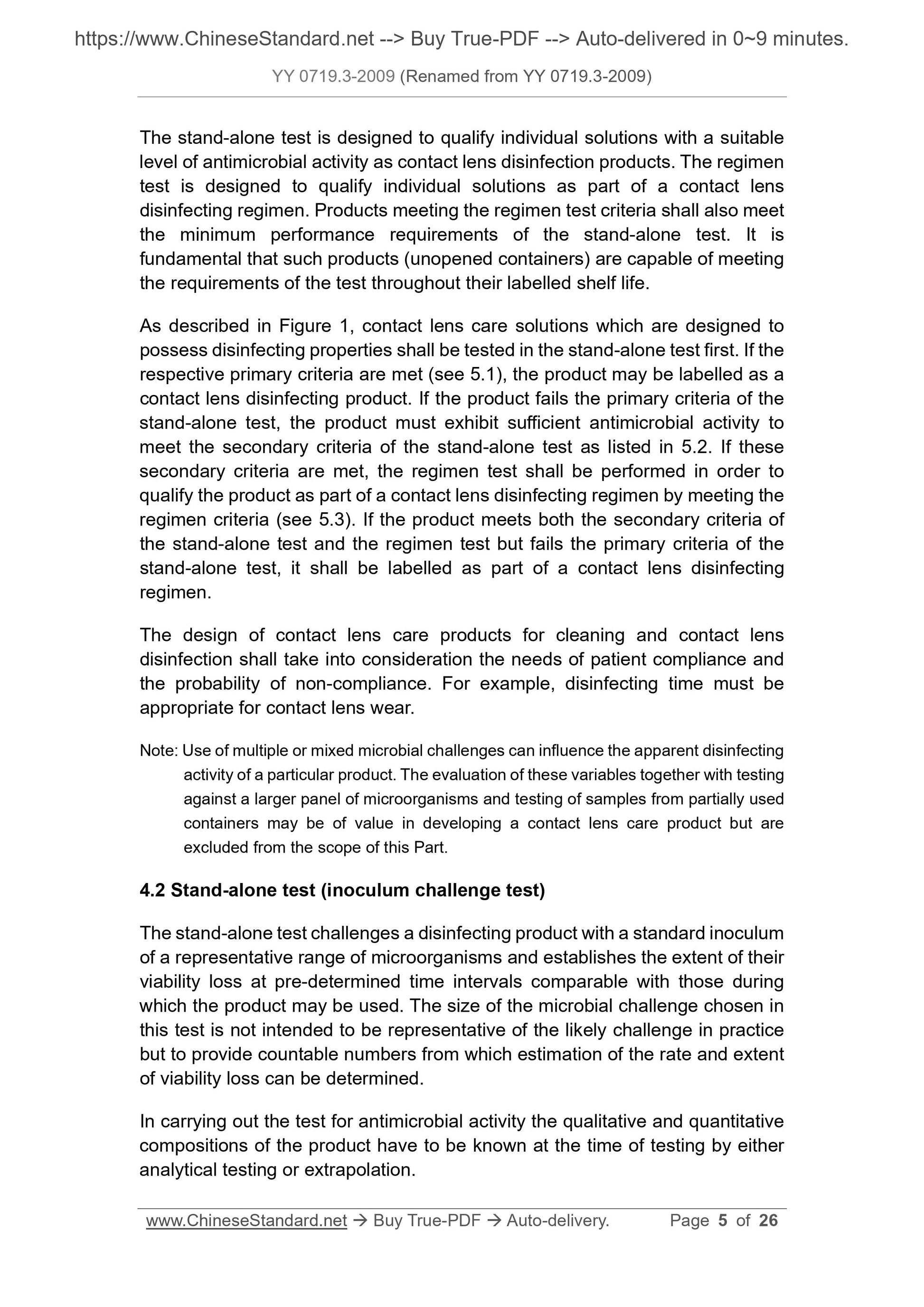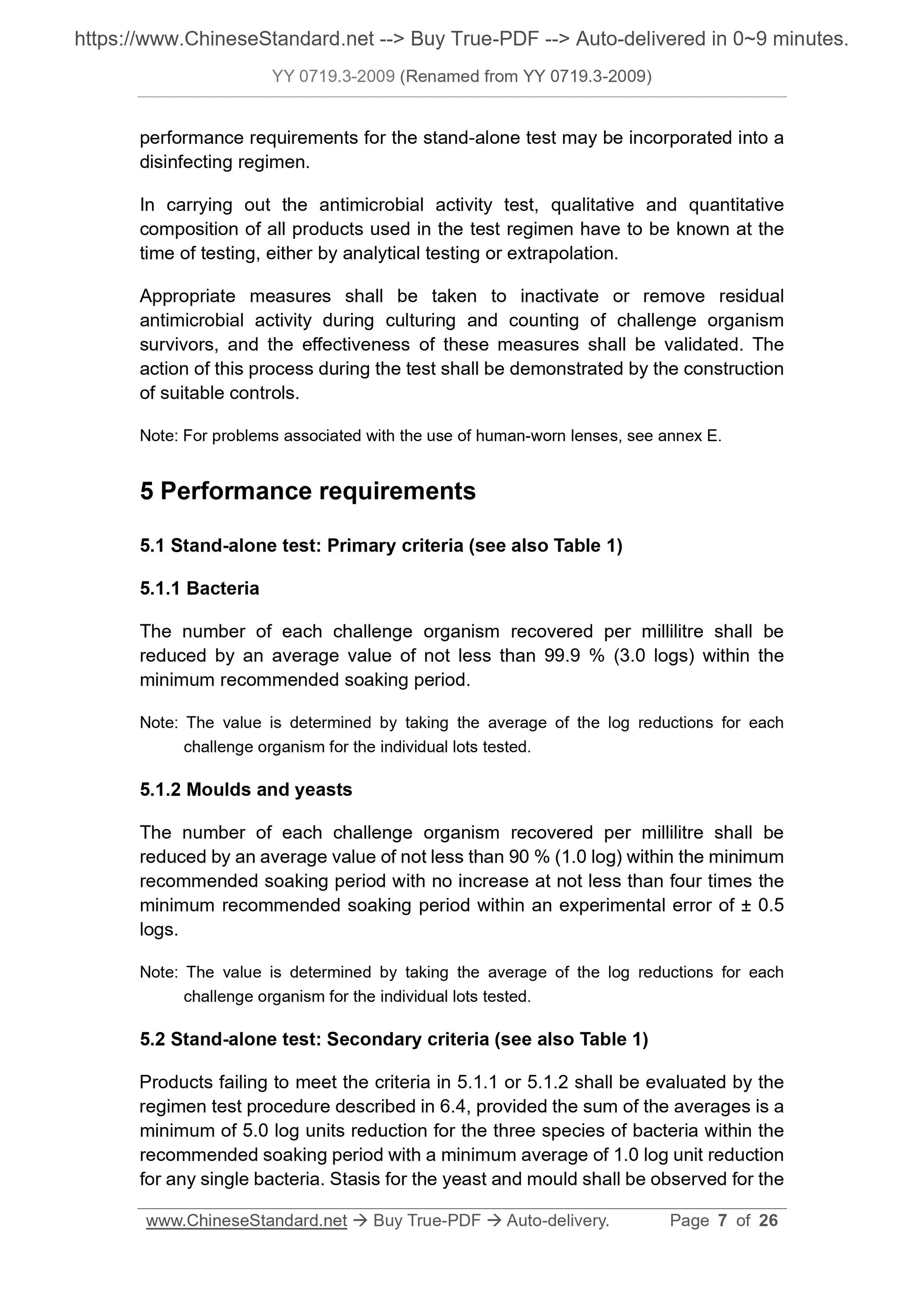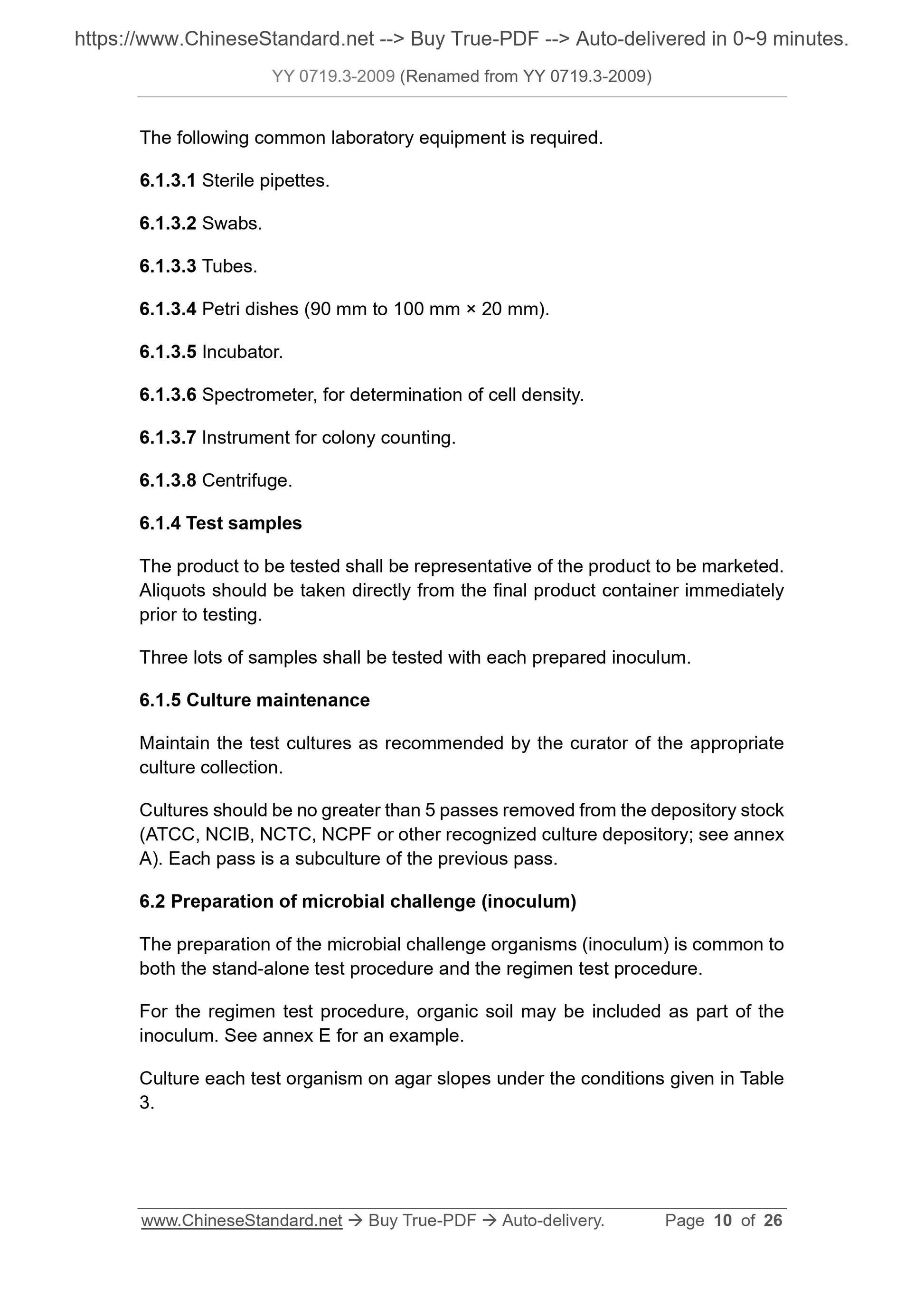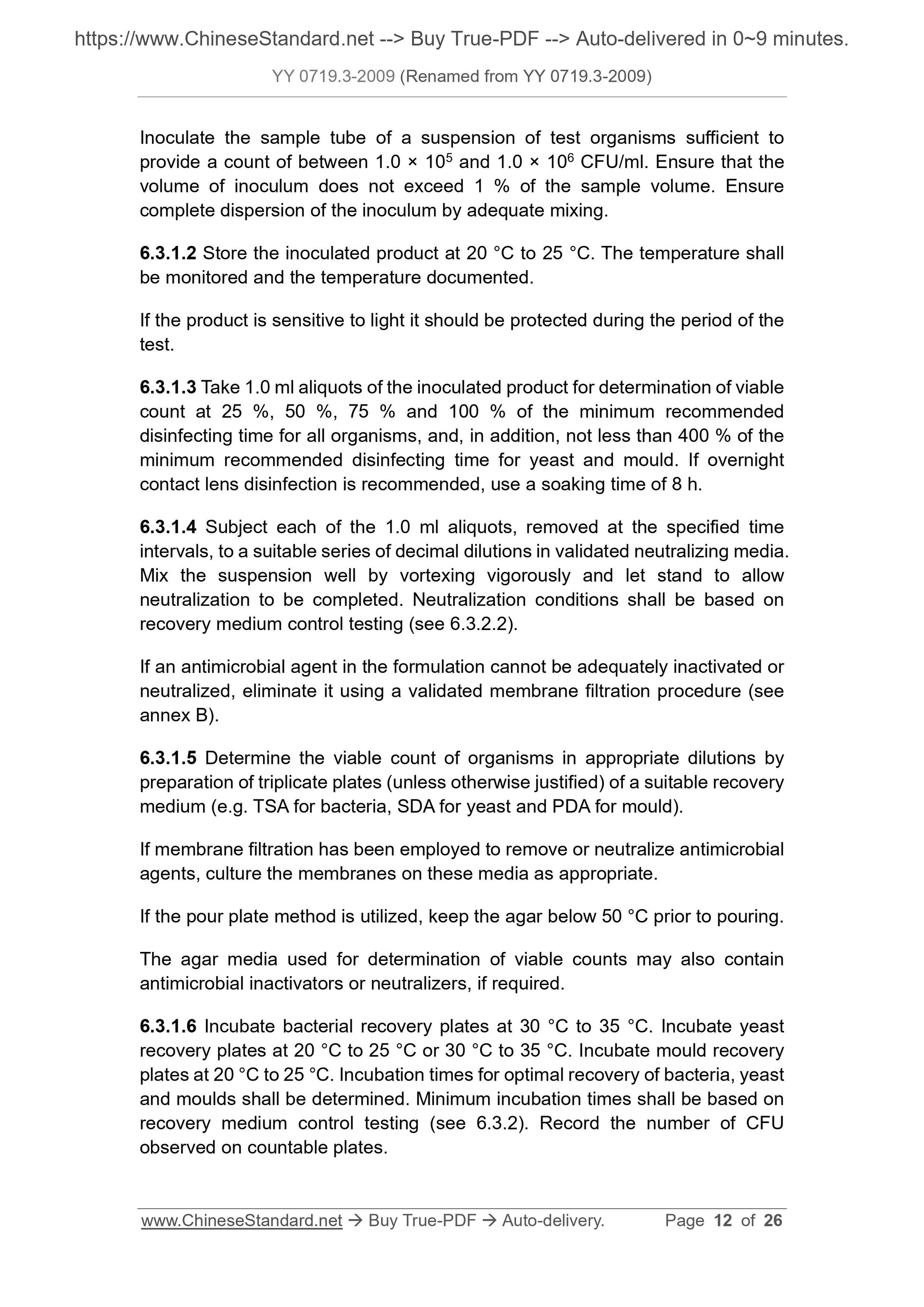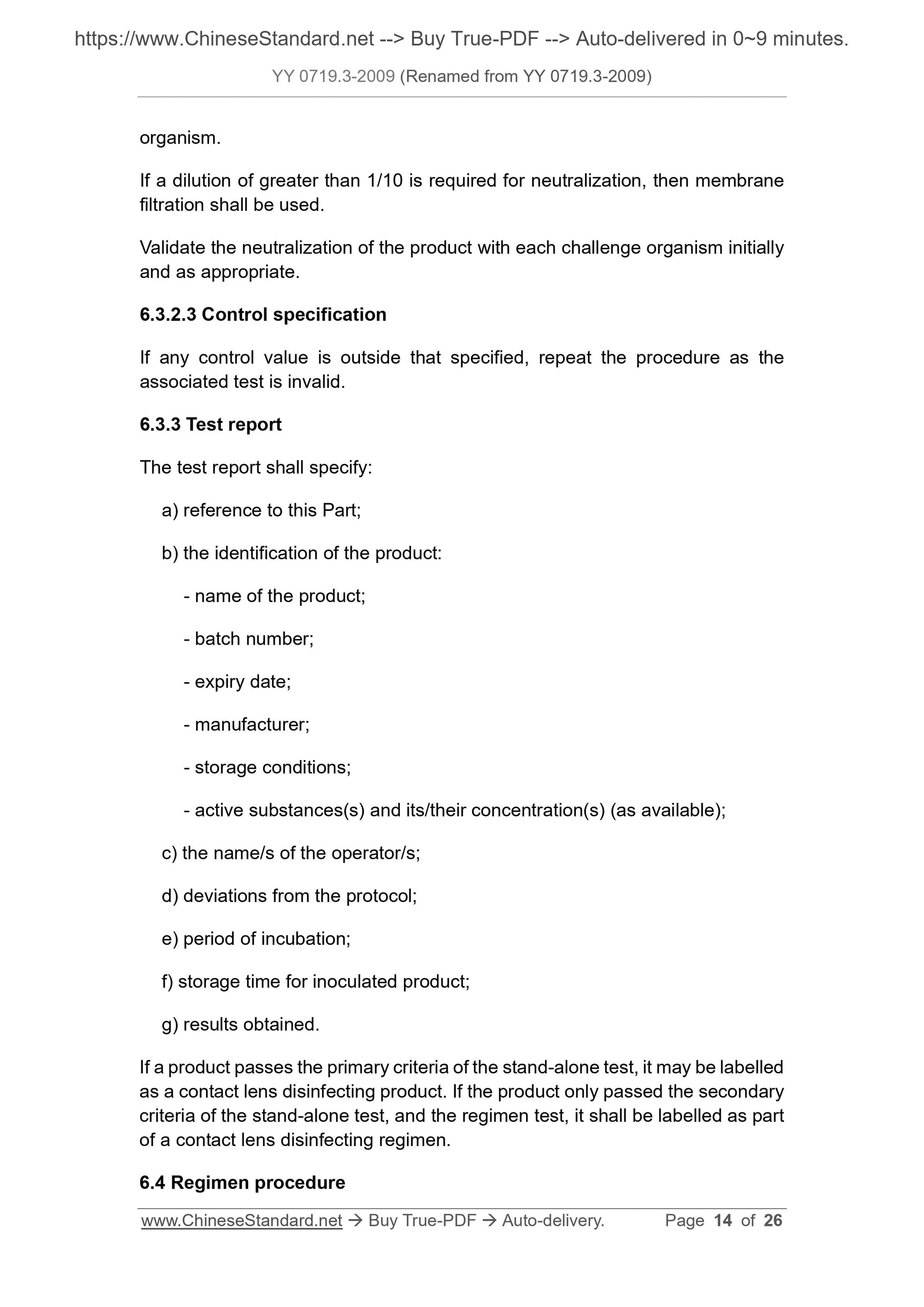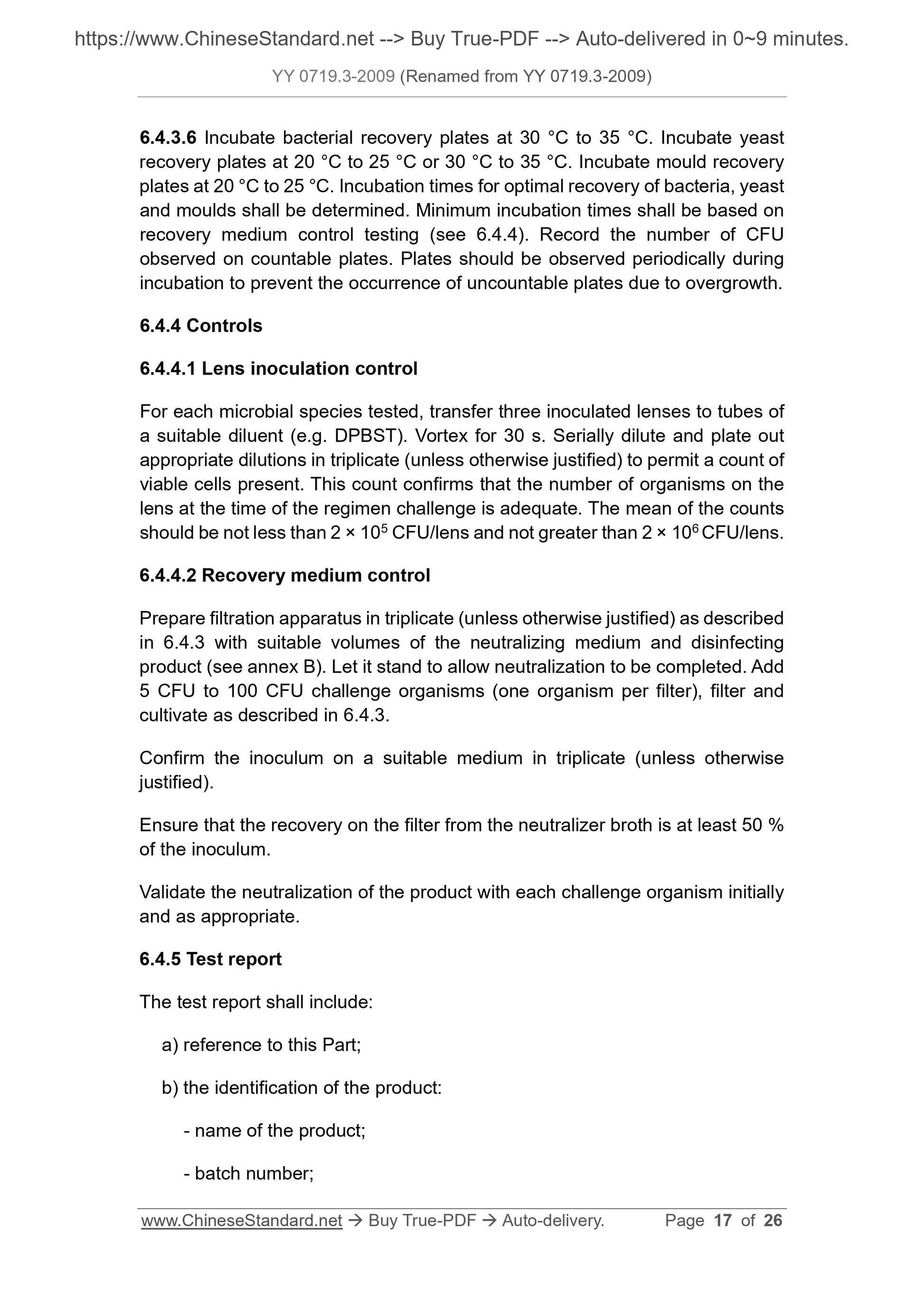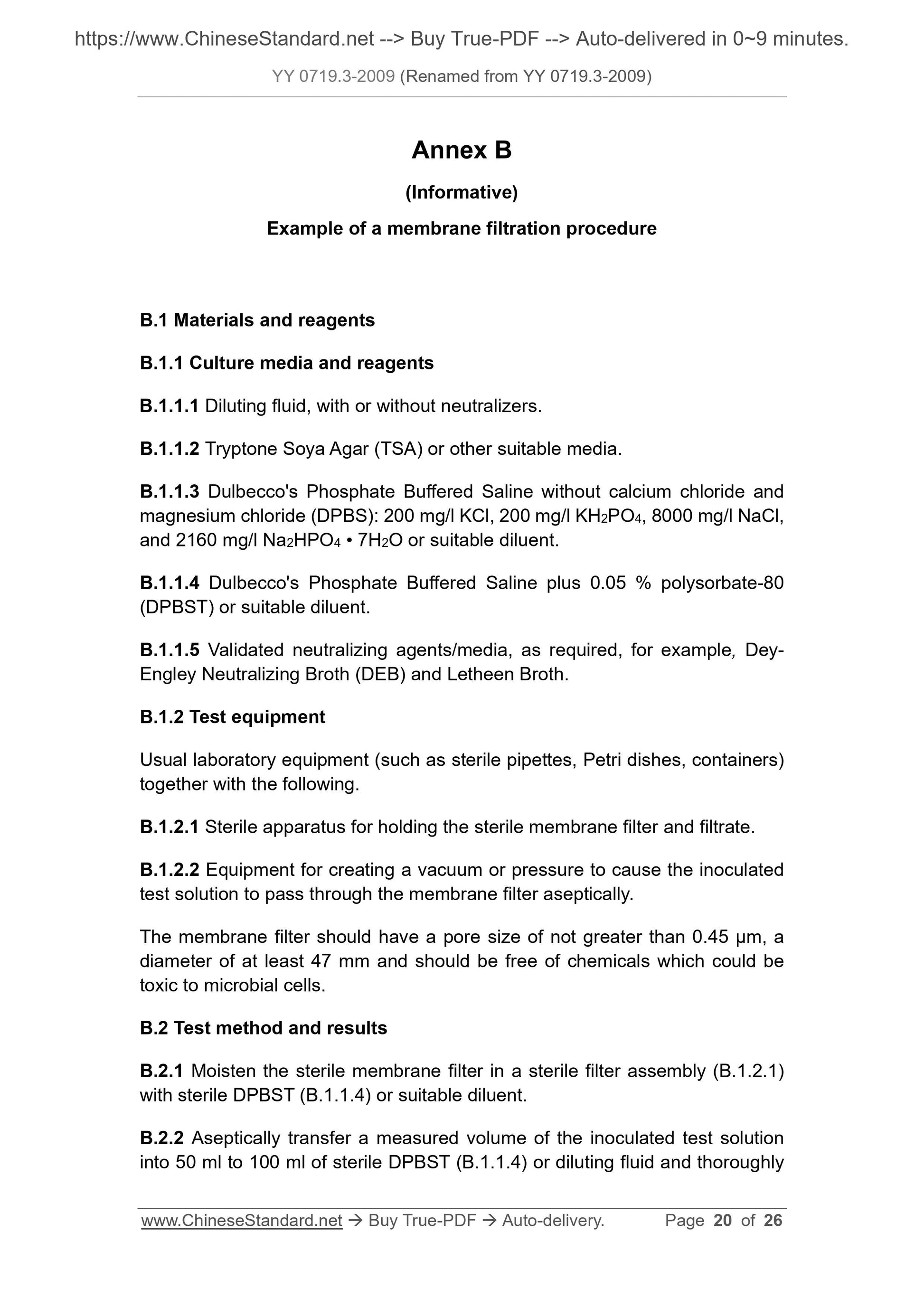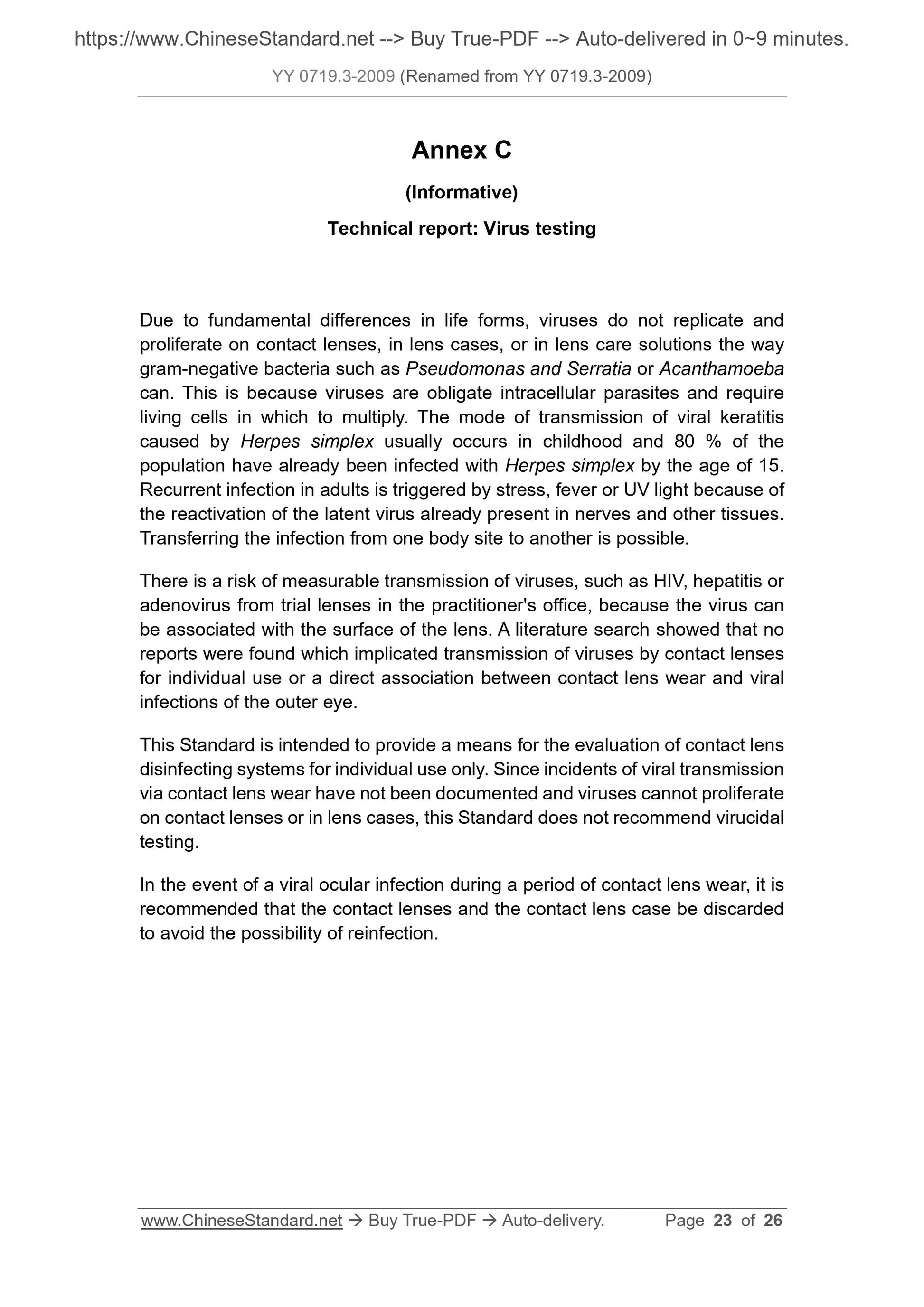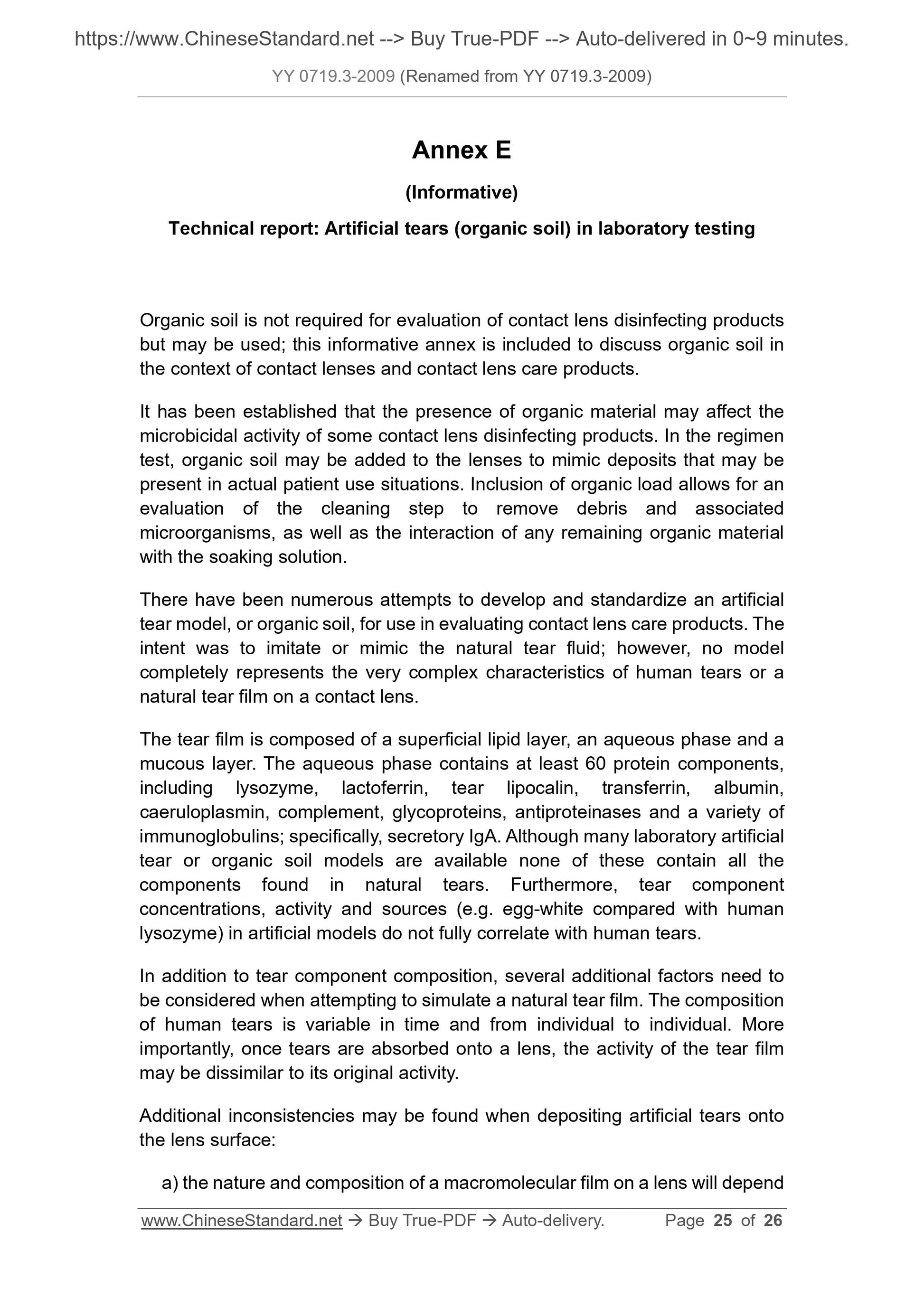1
/
of
12
PayPal, credit cards. Download editable-PDF and invoice in 1 second!
YY 0719.3-2009 English PDF (YY0719.3-2009)
YY 0719.3-2009 English PDF (YY0719.3-2009)
Regular price
$310.00 USD
Regular price
Sale price
$310.00 USD
Unit price
/
per
Shipping calculated at checkout.
Couldn't load pickup availability
Delivery: 3 seconds. Download true-PDF + Invoice.
Get QUOTATION in 1-minute: Click YY 0719.3-2009
Historical versions: YY 0719.3-2009
Preview True-PDF (Reload/Scroll if blank)
YY 0719.3-2009: Ophthalmic optics. Contact lens care products. Part 3: Microbiological requirements and test methods for products and regiments for hygienic managements of contact
YY 0719.3-2009 (Renamed from YY 0719.3-2009)
YY
PHARMACEUTICAL INDUSTRY STANDARD
OF THE PEOPLE’S REPUBLIC OF CHINA
ICS 11.040.70
C 40
YY/T 0719.3-2009
Ophthalmic optics - Contact lens care products -
Part 3: Microbiological requirements and test methods
for products and regimens for hygienic management
of contact
(ISO 14729:2001, MOD)
ISSUED ON: JUNE 16, 2009
IMPLEMENTED ON: DECEMBER 01, 2010
Issued by: China Food and Drug Administration
Table of Contents
Foreword ... 3
1 Scope ... 4
2 Normative references ... 4
3 Terms and definitions ... 4
4 Principle ... 4
5 Performance requirements ... 7
6 Test methods ... 9
Annex A (Informative) Test organisms from other culture collections ... 19
Annex B (Informative) Example of a membrane filtration procedure ... 20
Annex C (Informative) Technical report: Virus testing ... 23
Annex D (Informative) Technical report: Acanthamoeba testing ... 24
Annex E (Informative) Technical report: Artificial tears (organic soil) in laboratory
testing ... 25
Ophthalmic optics - Contact lens care products -
Part 3: Microbiological requirements and test methods
for products and regimens for hygienic management
of contact
1 Scope
This Part of YY 0719 specifies two test methods for evaluating the antimicrobial
activity of products to be marketed for contact lens disinfection by chemical
means and for products that are part of a contact lens care regimen.
This Part is not applicable to the hygienic management of trial lenses.
2 Normative references
The following documents contain provisions which, through reference in this
Part of YY 0719, constitute provisions of this Part. For the dated references,
their subsequent amendments (excluding corrections) or revisions do not apply
to this Part. However, the parties who enter into agreement based on this Part
are encouraged to investigate whether the latest editions of these documents
are applicable. For undated reference documents, the latest editions apply to
this Part.
YY 0719.1 Ophthalmic optics - Contact lens care products - Part 1:
Vocabulary
YY 0719.2 Ophthalmic optics - Contact lens care products - Part 2:
Fundamental requirements
3 Terms and definitions
For the purposes of this Part of YY 0719, the terms and definitions given in YY
0719.1 apply.
4 Principle
4.1 General
The stand-alone test is designed to qualify individual solutions with a suitable
level of antimicrobial activity as contact lens disinfection products. The regimen
test is designed to qualify individual solutions as part of a contact lens
disinfecting regimen. Products meeting the regimen test criteria shall also meet
the minimum performance requirements of the stand-alone test. It is
fundamental that such products (unopened containers) are capable of meeting
the requirements of the test throughout their labelled shelf life.
As described in Figure 1, contact lens care solutions which are designed to
possess disinfecting properties shall be tested in the stand-alone test first. If the
respective primary criteria are met (see 5.1), the product may be labelled as a
contact lens disinfecting product. If the product fails the primary criteria of the
stand-alone test, the product must exhibit sufficient antimicrobial activity to
meet the secondary criteria of the stand-alone test as listed in 5.2. If these
secondary criteria are met, the regimen test shall be performed in order to
qualify the product as part of a contact lens disinfecting regimen by meeting the
regimen criteria (see 5.3). If the product meets both the secondary criteria of
the stand-alone test and the regimen test but fails the primary criteria of the
stand-alone test, it shall be labelled as part of a contact lens disinfecting
regimen.
The design of contact lens care products for cleaning and contact lens
disinfection shall take into consideration the needs of patient compliance and
the probability of non-compliance. For example, disinfecting time must be
appropriate for contact lens wear.
Note: Use of multiple or mixed microbial challenges can influence the apparent disinfecting
activity of a particular product. The evaluation of these variables together with testing
against a larger panel of microorganisms and testing of samples from partially used
containers may be of value in developing a contact lens care product but are
excluded from the scope of this Part.
4.2 Stand-alone test (inoculum challenge test)
The stand-alone test challenges a disinfecting product with a standard inoculum
of a representative range of microorganisms and establishes the extent of their
viability loss at pre-determined time intervals comparable with those during
which the product may be used. The size of the microbial challenge chosen in
this test is not intended to be representative of the likely challenge in practice
but to provide countable numbers from which estimation of the rate and extent
of viability loss can be determined.
In carrying out the test for antimicrobial activity the qualitative and quantitative
compositions of the product have to be known at the time of testing by either
analytical testing or extrapolation.
performance requirements for the stand-alone test may be incorporated into a
disinfecting regimen.
In carrying out the antimicrobial activity test, qualitative and quantitative
composition of all products used in the test regimen have to be known at the
time of testing, either by analytical testing or extrapolation.
Appropriate measures shall be taken to inactivate or remove residual
antimicrobial activity during culturing and counting of challenge organism
survivors, and the effectiveness of these measures shall be validated. The
action of this process during the test shall be demonstrated by the construction
of suitable controls.
Note: For problems associated with the use of human-worn lenses, see annex E.
5 Performance requirements
5.1 Stand-alone test: Primary criteria (see also Table 1)
5.1.1 Bacteria
The number of each challenge organism recovered per millilitre shall be
reduced by an average value of not less than 99.9 % (3.0 logs) within the
minimum recommended soaking period.
Note: The value is determined by taking the average of the log reductions for each
challenge organism for the individual lots tested.
5.1.2 Moulds and yeasts
The number of each challenge organism recovered per millilitre shall be
reduced by an average value of not less than 90 % (1.0 log) within the minimum
recommended soaking period with no increase at not less than four times the
minimum recommended soaking period within an experimental error of ± 0.5
logs.
Note: The value is determined by taking the average of the log reductions for each
challenge organism for the individual lots tested.
5.2 Stand-alone test: Secondary criteria (see also Table 1)
Products failing to meet the criteria in 5.1.1 or 5.1.2 shall be evaluated by the
regimen test procedure described in 6.4, provided the sum of the averages is a
minimum of 5.0 log units reduction for the three species of bacteria within the
recommended soaking period with a minimum average of 1.0 log unit reduction
for any single bacteria. Stasis for the yeast and mould shall be observed for the
The following common laboratory equipment is required.
6.1.3.1 Sterile pipettes.
6.1.3.2 Swabs.
6.1.3.3 Tubes.
6.1.3.4 Petri dishes (90 mm to 100 mm × 20 mm).
6.1.3.5 In...
Get QUOTATION in 1-minute: Click YY 0719.3-2009
Historical versions: YY 0719.3-2009
Preview True-PDF (Reload/Scroll if blank)
YY 0719.3-2009: Ophthalmic optics. Contact lens care products. Part 3: Microbiological requirements and test methods for products and regiments for hygienic managements of contact
YY 0719.3-2009 (Renamed from YY 0719.3-2009)
YY
PHARMACEUTICAL INDUSTRY STANDARD
OF THE PEOPLE’S REPUBLIC OF CHINA
ICS 11.040.70
C 40
YY/T 0719.3-2009
Ophthalmic optics - Contact lens care products -
Part 3: Microbiological requirements and test methods
for products and regimens for hygienic management
of contact
(ISO 14729:2001, MOD)
ISSUED ON: JUNE 16, 2009
IMPLEMENTED ON: DECEMBER 01, 2010
Issued by: China Food and Drug Administration
Table of Contents
Foreword ... 3
1 Scope ... 4
2 Normative references ... 4
3 Terms and definitions ... 4
4 Principle ... 4
5 Performance requirements ... 7
6 Test methods ... 9
Annex A (Informative) Test organisms from other culture collections ... 19
Annex B (Informative) Example of a membrane filtration procedure ... 20
Annex C (Informative) Technical report: Virus testing ... 23
Annex D (Informative) Technical report: Acanthamoeba testing ... 24
Annex E (Informative) Technical report: Artificial tears (organic soil) in laboratory
testing ... 25
Ophthalmic optics - Contact lens care products -
Part 3: Microbiological requirements and test methods
for products and regimens for hygienic management
of contact
1 Scope
This Part of YY 0719 specifies two test methods for evaluating the antimicrobial
activity of products to be marketed for contact lens disinfection by chemical
means and for products that are part of a contact lens care regimen.
This Part is not applicable to the hygienic management of trial lenses.
2 Normative references
The following documents contain provisions which, through reference in this
Part of YY 0719, constitute provisions of this Part. For the dated references,
their subsequent amendments (excluding corrections) or revisions do not apply
to this Part. However, the parties who enter into agreement based on this Part
are encouraged to investigate whether the latest editions of these documents
are applicable. For undated reference documents, the latest editions apply to
this Part.
YY 0719.1 Ophthalmic optics - Contact lens care products - Part 1:
Vocabulary
YY 0719.2 Ophthalmic optics - Contact lens care products - Part 2:
Fundamental requirements
3 Terms and definitions
For the purposes of this Part of YY 0719, the terms and definitions given in YY
0719.1 apply.
4 Principle
4.1 General
The stand-alone test is designed to qualify individual solutions with a suitable
level of antimicrobial activity as contact lens disinfection products. The regimen
test is designed to qualify individual solutions as part of a contact lens
disinfecting regimen. Products meeting the regimen test criteria shall also meet
the minimum performance requirements of the stand-alone test. It is
fundamental that such products (unopened containers) are capable of meeting
the requirements of the test throughout their labelled shelf life.
As described in Figure 1, contact lens care solutions which are designed to
possess disinfecting properties shall be tested in the stand-alone test first. If the
respective primary criteria are met (see 5.1), the product may be labelled as a
contact lens disinfecting product. If the product fails the primary criteria of the
stand-alone test, the product must exhibit sufficient antimicrobial activity to
meet the secondary criteria of the stand-alone test as listed in 5.2. If these
secondary criteria are met, the regimen test shall be performed in order to
qualify the product as part of a contact lens disinfecting regimen by meeting the
regimen criteria (see 5.3). If the product meets both the secondary criteria of
the stand-alone test and the regimen test but fails the primary criteria of the
stand-alone test, it shall be labelled as part of a contact lens disinfecting
regimen.
The design of contact lens care products for cleaning and contact lens
disinfection shall take into consideration the needs of patient compliance and
the probability of non-compliance. For example, disinfecting time must be
appropriate for contact lens wear.
Note: Use of multiple or mixed microbial challenges can influence the apparent disinfecting
activity of a particular product. The evaluation of these variables together with testing
against a larger panel of microorganisms and testing of samples from partially used
containers may be of value in developing a contact lens care product but are
excluded from the scope of this Part.
4.2 Stand-alone test (inoculum challenge test)
The stand-alone test challenges a disinfecting product with a standard inoculum
of a representative range of microorganisms and establishes the extent of their
viability loss at pre-determined time intervals comparable with those during
which the product may be used. The size of the microbial challenge chosen in
this test is not intended to be representative of the likely challenge in practice
but to provide countable numbers from which estimation of the rate and extent
of viability loss can be determined.
In carrying out the test for antimicrobial activity the qualitative and quantitative
compositions of the product have to be known at the time of testing by either
analytical testing or extrapolation.
performance requirements for the stand-alone test may be incorporated into a
disinfecting regimen.
In carrying out the antimicrobial activity test, qualitative and quantitative
composition of all products used in the test regimen have to be known at the
time of testing, either by analytical testing or extrapolation.
Appropriate measures shall be taken to inactivate or remove residual
antimicrobial activity during culturing and counting of challenge organism
survivors, and the effectiveness of these measures shall be validated. The
action of this process during the test shall be demonstrated by the construction
of suitable controls.
Note: For problems associated with the use of human-worn lenses, see annex E.
5 Performance requirements
5.1 Stand-alone test: Primary criteria (see also Table 1)
5.1.1 Bacteria
The number of each challenge organism recovered per millilitre shall be
reduced by an average value of not less than 99.9 % (3.0 logs) within the
minimum recommended soaking period.
Note: The value is determined by taking the average of the log reductions for each
challenge organism for the individual lots tested.
5.1.2 Moulds and yeasts
The number of each challenge organism recovered per millilitre shall be
reduced by an average value of not less than 90 % (1.0 log) within the minimum
recommended soaking period with no increase at not less than four times the
minimum recommended soaking period within an experimental error of ± 0.5
logs.
Note: The value is determined by taking the average of the log reductions for each
challenge organism for the individual lots tested.
5.2 Stand-alone test: Secondary criteria (see also Table 1)
Products failing to meet the criteria in 5.1.1 or 5.1.2 shall be evaluated by the
regimen test procedure described in 6.4, provided the sum of the averages is a
minimum of 5.0 log units reduction for the three species of bacteria within the
recommended soaking period with a minimum average of 1.0 log unit reduction
for any single bacteria. Stasis for the yeast and mould shall be observed for the
The following common laboratory equipment is required.
6.1.3.1 Sterile pipettes.
6.1.3.2 Swabs.
6.1.3.3 Tubes.
6.1.3.4 Petri dishes (90 mm to 100 mm × 20 mm).
6.1.3.5 In...
Share
